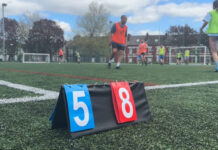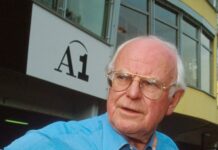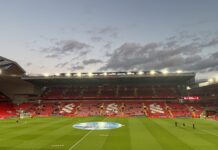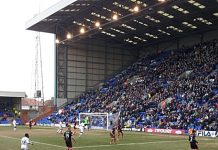With Everton set to move out of Goodison Park at the end of the season, many fans are wondering what will be done with their hallowed old stadium.
The men’s team are set to leave the Grand Old Lady after 133 years, and while a regeneration project has long been anticipated for Goodison, the idea of moving the women’s side to the old ground has also been raised.
Merseysportlive takes a look at other iconic English stadiums of the past, and what has become of them since the likes of Arsenal and Manchester City moved onto pastures new.
Highbury
It has nearly been 19 years since Arsenal moved out of the iconic Highbury to the Emirates Stadium.
Highbury, like Goodison Park, was designed by famous football stadium architect Archibald Leitch in the early 1900s, and is where most fans would say the club had its greatest years.
As for what remains of the ground today, the North Bank and iconic Clock End were demolished soon after the move, but the East and West stands still remain as Grade II listed buildings.
The stands now lay the foundation of Highbury Square, a luxurious apartment complex on the old site worth £500 million.
The Gunners’ glorious past is also still celebrated in the complex, with a bust of manager Herbert Chapman in the club’s famous marble corridors and the players’ tunnel still standing.
Maine Road
Before the Etihad and the billions that came with it, there was Maine Road, Manchester City’s home for 80 years until 2003.
The last season at the old ground in 2002/03 was a rather successful one.
Following promotion, the “Noisy Neighbours” won the Manchester derby for the first time in 13 years and qualified for Europe for the first time since 1978.
What followed was a move to the City of Manchester Stadium, which had been built for the 2002 Commonwealth Games and was later renamed to the Etihad Stadium under Emirati ownership.
The old stadium, despite some interest from rugby union side Sale Sharks, was demolished in late 2003.
In its place now stands a school and a new housing estate, the roads of which are named after players of the past, with other references to the club such as Blue Moon Way and Citizens Place.
The Dell
Home to Southampton for 103 years, The Dell was named after the land it was built on, a small valley covered with trees.
The Dell boasted a fascinating history, having to go through a number of renovations throughout the 20th century.
In fact, in the early years of the Second World War, Southampton had to move away from The Dell after a bomb landed in the Milton Road end’s penalty area, leaving an 18-foot crater which flooded the ground.
The Saints moved back to The Dell in 1941, and stayed there until 2001, after it was decided that for a Premier League club whose stadium had now been capped at a 15,200 capacity, it was time to move on.
After failed plans and local council disputes in the mid-1990s, the club moved to St Mary’s Stadium, a 32,600-seater stadium on a disused gas work site where the club have remained ever since.
The site of the old stadium is now used for a mixture of houses and apartment blocks, named after former Saints players, such as Le Tissier Court.
Within the buildings there are subtle reminders of what once was, with pictures of the stadium and former players in the lobbies as well as other football-themed decorations.
Filbert Street
After 111 years at their old Filbert Street stadium, Leicester City moved to the King Power in 2002.
The final season at their old ground was not one to remember, as the Foxes won just five games in the entirety of the 2001/02 campaign and were relegated to the First Division.
And yet the last ever match at Filbert Street is still remembered fondly, a 2-1 victory over Tottenham Hotspur thanks to a 71st minute winner from academy graduate Matt Piper.
While a stadium expansion was the club’s first option, the old site was sold to developers for £3.75 million, and is now mostly used as accommodation for students at the University of Leicester and De Montfort University.
The road that runs through what is now ‘Filbert Village’ is called Lineker Road, named after club legend Gary Lineker, who started his career with the Foxes.
However, part of the site is still derelict more than 20 years on, with plans for more housing affected by the 2008 financial crisis, and car parking plans dropped by the city council in 2012.
Victoria Ground
While only part of Leicester’s old ground remains derelict, the whole site of Stoke City’s former Victoria Ground was a barren wasteland for 15 years following the club’s move to the Britannia Stadium in 1997.
Commonly known as The Vic, the stadium had been the longest operational football ground in the country, with 119 years of continuous use.
But after new rules in the 1990s demanded top-tier clubs to have all-seater stadiums, the switch to a new 25,000-seater stadium was made and The Vic was demolished.
As for the demolition site, various plans failed over a number of years, with a lack of progress being blamed on the potential for flooding and the financial crisis of the late 2000s.
In 2008, however, a breakthrough was made and the land was sold to property developers, with hundreds of homes now on the site, as well as a walking trail along the River Trent.
Similarly to other old sites, the streets also commemorate former players, such as Paul Ware and Frank Bowyer.
And what about Everton?
Following Everton’s move to their new state-of-the-art Bramley Moore Stadium, the Goodison Legacy Project includes demolition of the old ground and a regeneration plan for housing, offices and other facilities.
However, the Times has reported that the new club owners The Friedkin Group have launched a ‘feasibility study’ into the possibility of moving Everton Women to Goodison Park.
Could Goodison Park become the new home for Everton Women?
The club's owners are giving it serious consideration, @_pauljoyce reports 🔽https://t.co/LSYOhB2Bqw
— Times Sport (@TimesSport) April 1, 2025
The women’s side currently play at Walton Hall Park, but with only 500 seats, the facilities will soon no longer meet Women’s Super League stadium requirements.
It has also been reported that regardless of whether the women’s team relocates to Goodison Park, the project will still ensure that the site is put to use for the benefit of the community.
(Featured image: Goodison Park, Maine Road, and Highbury – Images used under Wikimedia Creative Commons – Attributed to Derek Harper, Martin Thirkettle, and Qwghlm respectively)
















